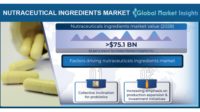Market Research
3 Promising Animal Feed Protein Ingredients Likely to Gain Traction Through 2027

Despite the proliferating trend of veganism, meat consumption remains consistent worldwide. Today, the intake stands at around 350 million tons annually. A reliable source anticipates global meat consumption to reach between 460 million to 570 million tons by 2050. These statistics imply that animals continue to make important contributions to the global food supply, making animal feed a crucial component of the integrated food chain.
Addressing consumer demand for more milk, meat, eggs and other livestock products necessitates more dependency on the availability of regular supplies of cost-effective, safe and proper animal feed. Feeds enriched with proteins and nutrients for improved animal health are highly preferred by farm owners.
Animal protein meals are an ideal source of essential nutrients and amino acids which boost the immunity of livestock. Moreover, these feeds enable amino acid synthesis which helps in augmenting the productivity and performance of animals, supporting the expansion of animal feed protein ingredients market over the recent years.
Numerous companies operating in the feed and nutrition sector are putting their best foot forward to strengthen their presence in the expanding animal feed protein ingredients industry. Cargill, for instance, recently made it to the headlines for its partnership with Innovafeed. The latest alliance, which was established in June 2022, is committed to identifying and cultivating eco-friendly protein ingredients and developing fish nutrition that promotes and improves the health of farmed fish.
A ‘Livestock Revolution’: 3 Important Protein Ingredients That Could Augment the Nutritional Value of Animal Feeds
1. Soybean
Soybean remains one of the most important sources of high-quality vegetable protein in animal feed. Soymeal, a byproduct of oil extraction boasts high crude protein content of nearly 44% to 50% and a balanced amino acid composition. It represents two-thirds of the world’s output of protein feedstuffs, including major oil and fish meals.
It is pivotal to note that almost 80% of the world’s soybean crop is used to feed livestock, especially for chicken, beef, egg and dairy production. Several companies are shifting to the production, commercialization and distribution of soybean crops and meals. They are depicting a keen interest in mergers, acquisitions and new product launches that may increase soybean demand.
In 2021, ADM announced the acquisition of Sojaprotein, a pioneer in non-GMO soy ingredients supplier. The deal presented a significant expansion to the former’s global alternative protein capabilities and the ability to meet the growing demand for plant-based ingredients for animal feed.
While soybean remains a highly acclaimed protein ingredient in animal feed, price volatility associated with crop cultivation and concerns around sustainable farming have introduced new alternatives to the ingredient, like insect meal.
2. Insect meal
Insect protein and insect meal are the latest substitutes for other feed protein sources like soybean meal. Insect meal contains up to approximately 80% protein and is nutritious, economical and can be produced locally. It is particularly suitable to feed insect protein to livestock types like poultry and fish as insects are a natural source of food for their wild counterparts. To that end, several R&D programs to validate the nutritional profile of insect meal are underway.
A research team at the University of Sao Paulo’s Department of Animal Science concluded that mealworm stands to be a favorable protein ingredient for poultry diets. It has been reported that chickens prefer consuming insect larvae meals for increased performance and strength.
In 2021, the Association of American Feed Control Officials approved the use of dried black soldier flies in adult dog food. This paved way for companies to develop novel solutions in insect protein for animal feed. InnovaFeed, for example, inked a strategic partnership with ADM to expand its insect protein business for the pet food industry.
Insect meal is likely to help countries achieve their climate change goals. Reliable studies prove that a shift to insect-based animal feeds could assist the UK to achieve its net-zero carbon emissions target by 2050 end. Insect-based feeds provide a promising method to tackle emissions from agriculture in the UK in a sustainable and low-carbon way.
3. Blood meal
Blood meals deliver high protein content, about 90% to 95%, owing to the presence of digestible protein and other essential amino acids. The ingredient is an ideal supplement for all livestock that are dependent on plant-based diets, cereal grains or different forages.
Blood meal is primarily used as fish meal, as it improves fish growth and feed efficacy, thereby propelling the demand for blood meal across the animal feed protein ingredients industry across diverse regions.
Favorable Regulatory Policies to Influence Europe Animal Feed Protein Ingredients Market Outlook
According to the regional purview, the demand for animal feed protein ingredients is touted to rise considerably across the European economies. This upsurge is on account of an increase in the implementation of favorable regulatory policies in the region.
To illustrate, in August 2021, the EU certified the use of processed animal proteins secured from insects (insect PAPs) in pig and poultry feed. The Commission Regulation (EU) 2021/1372 regarding the act was published in the Official Journal of the European Union. The act was embraced by the International Platform of Insects for Food and Feed (IPIFF).
According to reliable sources, the regulation is seen as a monumental step in the upscaling of the European insect sector. The act is expected to play a vital role in fostering circularity in food production, enhancing the self-sufficiency and sustainability of the livestock sector in Europe.
In the following years, the demand for animal feed protein ingredients is slated to surge appreciably with more focus being laid on dietary proteins among people, supported by a rise in economic standards. While the industry is estimated to gain considerable remuneration from Europe, the Asia Pacific and North America regions are also poised to emerge as key hotspots by 2027.Looking for a reprint of this article?
From high-res PDFs to custom plaques, order your copy today!





